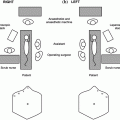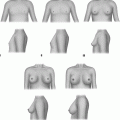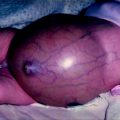Tumour
Symptoms
Insulinoma
Confusion, sweating, weakness, unconsciousness, relief of symptoms with eating
Gastrinoma
Peptic ulceration and diarrea (Zollinger-Ellison syndrome, or diarrea alone
Glucagonoma
Weight loss, diabetes mellitus, diarrea, necrolytic migratory erythema
VIPoma
Profuse diarrea and marked hypokalaemia (Verner-Morrison syndrome)
Somatostatinoma
Weight loss, diarrea, steatorrhea, diabetes mellitus
Gastrinomas are diagnosed by an increased gastric acid output with pH <2.0 in association with raised fasting serum gastrin levels [20, 21]. It is important to ensure that proton pump inhibitors have been stopped for at least 1 week prior to gastrin levels being measured, as these agents can lead to a falsely elevated gastrin level.
Diagnostic localisation of gastrinomas can be achieved through cross-sectional imaging (CT and MRI), functional positron emission tomography (PET), and octreoscan/single photon emission tomography (SPECT). Given the multiple nature of these tumours, it is important to visualise the whole gastrinoma triangle, as well as carefully evaluating the liver for potential metastatic disease.
Insulinomas
Insulinomas are insulin-secreting PaNETs arising from the beta cells of the islets of Langerhans and, as such, patients present with symptoms of hyperinsulinism. Depending on the age of the child, symptoms include sweating, weakness, unconsciousness, and confusion. Symptoms improve with feeding. Biochemical diagnosis demonstrates fasting hypoglycaemia with inappropriately raised plasma insulin, and C-peptide levels [22]. The combination of symptoms of hypoglycaemia (especially after fasting or heavy exercise), a low plasma glucose measured during these symptoms, and relief of the symptoms once blood glucose has been normalised, is termed the Whipple’s triad.
Other Functioning PNETs
Vasoactive intestinal polypeptide (VIP)–omas are rare PanNETs secrete VIP that cause the WDHA or Verner-Morrison syndrome. This comprises watery diarrhoea, hypokalaemia and achlorhydria, resulting in severe acidosis and dehydration. Unlike in adults, VIPomas in children are mainly non-pancreatic in origin.
Glucagonomas arise from the glucagon-secreting pancreatic alpha cells. Glucagonomas present with weight loss, anaemia, hyperglycaemia, and a characteristic rash known as necrolytic migratory erythema.
Somatostatinomas arise from islet delta-cells and usually present with weight loss, diarrhoea, steatorrhea and diabetes mellitus. Pancreatic polypeptide (PP)–omas secrete PP. However, elevated serum PP is also found in association with some ‘non-functioning’ PanNETs. However, PPomas and somatostatinomas are often asymptomatic [23, 24]. Sporadic glucagonomas and somatostatinomas do not seem to have been reported in children.
Other rare forms of functioning PaNETs include PaNETs that secrete adrenocorticotropic hormone (ACTH), corticotropin-releasing hormone (CRH), parathyroid hormone-related peptide (PHRP), growth hormone-releasing hormone (GHRH), gonadotropin-releasing hormone (CRH) or calcitonin (GRF).
Non-functioning PaNETs
Non-functioning PaNETs can be large and often present late. Indeed, about 50% of non-functioning PaNETs have metastasised by the time of clinical presentation [25]. Symptoms may be due to the local effects of the pancreatic mass and/or the hepatic metastases.
Diagnosis
Diagnosis is based on a combination of clinical presentation, detection of circulating NET secretions, and a range of different imaging techniques [25]. Tissue diagnosis by histopathology then confirms the diagnosis. Children with a family history of MEN1 or who are known to have a genetic predisposition to developing PNETs, should be screened for possible tumours. There is however, an ongoing debate concerning at what age screening should commence.
Biochemical Tests
Measuring the specific secretions produced by functioning PaNETS helps make the diagnosis in the first place, as well as being a useful way of monitoring tumour progression and resolution following treatment [26]. In addition, there are a number of less-specific substances that are produced by many gastro-pancreatic NETs regardless of their anatomical location and regardless of whether they are clinically functional tumours. These include pancreatic polypeptide which is produced by more than 30% of GEP-NETs, and also chromogranin A (CgA) [25, 27]. However, care has to be taken to recognise that CgA is also elevated in patients with atrophic gastritis, renal insufficiency, and who are on treatment with proton pump inhibitors [28].
Imaging
Diagnostic imaging consists of a combination of routine and specialist radiological and nuclear investigations [25, 28]. Most NETs require a multi-modality approach for accurate localisation and staging. Cross-sectional imaging (CT and MRI) plays an important role in initial localisation, as somatostatin receptor scintigraphy (SSRS). MIBG Scintigraphy can be useful in diagnosing PaNETs that do not take up somatostatin analogues. PET/CT is the imaging of choice for localising insulinoma in adults with either FDOPA or GLP-1 as the isotope. However, this is unavailable for children in most centres. Serial venous sampling therefore, still has a place as a localisation modality. Endoscopic ultrasound can be useful for detecting pancreatic GEP-NETs, and intraoperative ultrasound can help identify tumour extent and the presence of multifocal disease at the time of surgery.
Management
Due to the rare and complex nature of PaNETs in children, it is paramount that these are managed within a multi-disciplinary team. Such a team should comprise a paediatric surgeon, a paediatric endocrinologist, an adult pancreatic surgeon, experienced diagnostic and interventional radiologist, and an oncologist with experience of managing advanced and malignant PaNETs. Combining the expertise of paediatric and adult specialists ensures that children with PaNETs have the very best care possible for this rare and challenging condition.
Consensus guidelines exist for the management of many PaNETs [25]. However, most of these have been designed for adults rather than children. Modified guidelines are needed for children, although the rarity of these cases in this age-group means that these are hard to generate in an evidence-based manner.
Management of Functioning PaNETs
Surgical Management
Complete surgical resection offers the only curative treatment for neuroendocrine tumours. However, radical resection may be required, and the tendency to multifocal disease must always be taken into account in planning surgical treatment. When non-resectable or metastatic disease is present, surgery aimed at ablating or debulking the tumour burden can significantly improve length of patient survival, and it can contribute considerably to quality of life [28]. The use of novel intraoperative techniques, such as radio-frequency ablation and cryotherapy, have further aided the surgical treatment of advanced disease. Recent advances in medical treatment for advanced PaNETs has been encouraging with early evidence of prolonged survival.
The optimal surgical therapy for gastrinomas remains controversial [29]. Surgery for gastrinomas is rarely curative due to their small size and multiplicity.
Curative surgery to enucleate the tumour or a partial pancreatic resection is the aim of treatment for patients with these symptomatic functioning pancreatic tumours.
Pancreatic resection is beneficial for functioning glucagonoma and VIPoma NETs, as medical therapy is unsatisfactory.
Non-operative Management
Medical therapies for gastrinomas include proton pump inhibitors and somatostatin analogues to suppress hyperacidity. Treatment of inoperable or metastatic PNETs includes biotherapy (e.g. somatostatin analogues and interferon-α), targetted radionuclide therapy, locoregional treatments and chemotherapy [13, 27, 30, 31]. Inhibitors of tyrosine kinase receptors (TKRs) and of the mammalian target of rapamycin (mTOR) signalling pathway have recently been reported to be effective in treating PaNETs [32, 33]. Sunitinib, which inhibits TKRs, and Everolimus, which is an inhibitor of mTOR, in randomised placebo-controlled trials improved median progression-free survival when compared to patients treated with placebo (11.4 months vs. 5.5 months and 11.0 months vs. 4.6 months, respectively, P < 0.001) in adults with advanced or progressive well-differentiated pancreatic NETs [32, 33]. Somatostatin biotherapy has antitumour and antiproliferative effects, and the CLARINET phase III trial of depot lanreotide treatment significantly prolonged progression-free survival in patients with metastatic pancreatic NETs [34].
Periodic endoscopic surveillance of the upper gastrointestinal tract in those with hypergastrinemia is beneficial for the identification of peptic ulcer disease and gastric carcinoid tumours [35].
Management of Non-functioning PaNETs
The role of surgery for non-functioning pancreatic tumours is controversial, but should be considered for tumours that demonstrate significant growth over 6 months or are >1 cm in size [3, 29].
Stay updated, free articles. Join our Telegram channel

Full access? Get Clinical Tree






